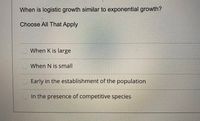
Human Anatomy & Physiology (11th Edition)
11th Edition
ISBN: 9780134580999
Author: Elaine N. Marieb, Katja N. Hoehn
Publisher: PEARSON
expand_more
expand_more
format_list_bulleted
Concept explainers
Question

Transcribed Image Text:When is logistic growth similar to exponential growth?
Choose All That Apply
When K is large
When N is small
Early in the establishment of the population
In the presence of competitive species
Expert Solution
This question has been solved!
Explore an expertly crafted, step-by-step solution for a thorough understanding of key concepts.
This is a popular solution
Trending nowThis is a popular solution!
Step by stepSolved in 2 steps

Knowledge Booster
Learn more about
Need a deep-dive on the concept behind this application? Look no further. Learn more about this topic, biology and related others by exploring similar questions and additional content below.Similar questions
- In an exponentially growing population, the rate of growth ( ) is 1.4. If there are 150 organisms this year, what will the population size be after 2 years?arrow_forwardin 2021, the growth rate of the human population was 1.03% per year with a thencurrent population of 7.875 billion people. Assuming a carrying capacity of 15 billionindividuals,when will the population reach 14.5 billion (i.e., nearly carrying capacity)?arrow_forwardWhat is the name of the model that exhibits the maximum rate of population growth? Select one: Logistic Factorial Exponential Speculativearrow_forward
- What is the major difference between the geometric population growth equation and the exponential population growth equation and when would you use one over the other?arrow_forwardJust Explain the difference between density-independent and a density-dependent processes influencing population growth. Each of the example show up.arrow_forwardThe population of individuals is growing at a continuous rate. The maximum growth rate is 0.35 and the carrying capacity of the population is 800 individuals. a. If the population size is 20 individuals, find the population growth rate. Show your work. b. If the population was nearing the carrying capacity, how would this rate compare to the calculated rate in part a? A calculation is not required.arrow_forward
- Given that white-tailed deer give birth to fawns each spring, which population growth model would be the most appropriate and why?arrow_forwardExamine the characteristics of logistic growth by completing each statement. Not all choices will be used. *1 S exponential four competition follicular lag two J stable equilibrium Logistic growth results in a(n) curve when graphed. This growth curve exhibits time. The phase exhibits a slow growth rate due to the small number of individuals within the population early on. Exponential growth slows as increases during the deceleration phase. As the population size grows, the growth rate will accelerate due to biotic potential during what is called the growth phase. -shaped growth distinct phases over Finally, the carrying capacity is reached during the < Prey n for resources phase where birth and death rates are equalarrow_forwardWhy does the growth curve line become flat after initially increasing? The population growth rate has slowed. The population growth rate has increased. The population has reached maximum sustainable yield. The population is experiencing density-independent growth.arrow_forward
arrow_back_ios
arrow_forward_ios
Recommended textbooks for you
 Human Anatomy & Physiology (11th Edition)BiologyISBN:9780134580999Author:Elaine N. Marieb, Katja N. HoehnPublisher:PEARSON
Human Anatomy & Physiology (11th Edition)BiologyISBN:9780134580999Author:Elaine N. Marieb, Katja N. HoehnPublisher:PEARSON Biology 2eBiologyISBN:9781947172517Author:Matthew Douglas, Jung Choi, Mary Ann ClarkPublisher:OpenStax
Biology 2eBiologyISBN:9781947172517Author:Matthew Douglas, Jung Choi, Mary Ann ClarkPublisher:OpenStax Anatomy & PhysiologyBiologyISBN:9781259398629Author:McKinley, Michael P., O'loughlin, Valerie Dean, Bidle, Theresa StouterPublisher:Mcgraw Hill Education,
Anatomy & PhysiologyBiologyISBN:9781259398629Author:McKinley, Michael P., O'loughlin, Valerie Dean, Bidle, Theresa StouterPublisher:Mcgraw Hill Education, Molecular Biology of the Cell (Sixth Edition)BiologyISBN:9780815344322Author:Bruce Alberts, Alexander D. Johnson, Julian Lewis, David Morgan, Martin Raff, Keith Roberts, Peter WalterPublisher:W. W. Norton & Company
Molecular Biology of the Cell (Sixth Edition)BiologyISBN:9780815344322Author:Bruce Alberts, Alexander D. Johnson, Julian Lewis, David Morgan, Martin Raff, Keith Roberts, Peter WalterPublisher:W. W. Norton & Company Laboratory Manual For Human Anatomy & PhysiologyBiologyISBN:9781260159363Author:Martin, Terry R., Prentice-craver, CynthiaPublisher:McGraw-Hill Publishing Co.
Laboratory Manual For Human Anatomy & PhysiologyBiologyISBN:9781260159363Author:Martin, Terry R., Prentice-craver, CynthiaPublisher:McGraw-Hill Publishing Co. Inquiry Into Life (16th Edition)BiologyISBN:9781260231700Author:Sylvia S. Mader, Michael WindelspechtPublisher:McGraw Hill Education
Inquiry Into Life (16th Edition)BiologyISBN:9781260231700Author:Sylvia S. Mader, Michael WindelspechtPublisher:McGraw Hill Education

Human Anatomy & Physiology (11th Edition)
Biology
ISBN:9780134580999
Author:Elaine N. Marieb, Katja N. Hoehn
Publisher:PEARSON

Biology 2e
Biology
ISBN:9781947172517
Author:Matthew Douglas, Jung Choi, Mary Ann Clark
Publisher:OpenStax

Anatomy & Physiology
Biology
ISBN:9781259398629
Author:McKinley, Michael P., O'loughlin, Valerie Dean, Bidle, Theresa Stouter
Publisher:Mcgraw Hill Education,

Molecular Biology of the Cell (Sixth Edition)
Biology
ISBN:9780815344322
Author:Bruce Alberts, Alexander D. Johnson, Julian Lewis, David Morgan, Martin Raff, Keith Roberts, Peter Walter
Publisher:W. W. Norton & Company

Laboratory Manual For Human Anatomy & Physiology
Biology
ISBN:9781260159363
Author:Martin, Terry R., Prentice-craver, Cynthia
Publisher:McGraw-Hill Publishing Co.

Inquiry Into Life (16th Edition)
Biology
ISBN:9781260231700
Author:Sylvia S. Mader, Michael Windelspecht
Publisher:McGraw Hill Education